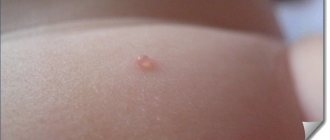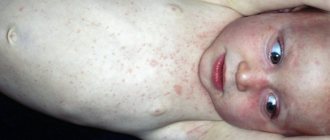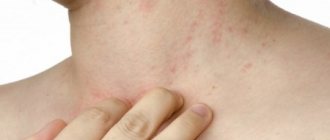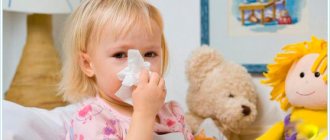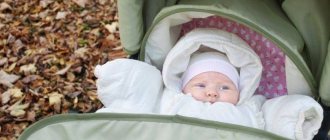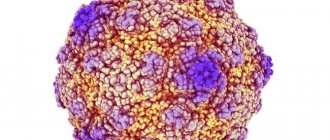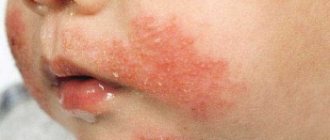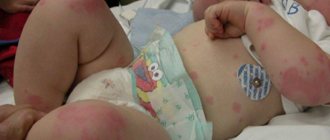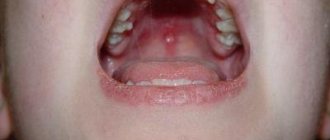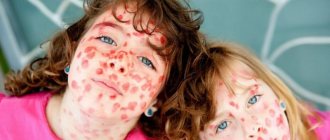Allergy is a systemic immunopathological reaction of the body (almost always acute) to contact with allergens or pathogens, subject to previous sensitization to this allergen. The mechanism of allergy development has not been fully studied, so it is impossible to accurately identify the causes of such reactions, but factors that can provoke hypersensitive immune responses to interaction with foreign protein structures have been precisely established. Almost 60% of patients with various forms of allergies are children, half of them are infants of the first year of life.
Allergies in infants are a very common phenomenon caused by instability and immaturity of immune cells. In clinically severe cases, an allergic reaction can lead to the death of a child, so parents should know how the pathology manifests itself and be able to differentiate it from other diseases, as well as provide first aid to an infant with signs of an acute allergic reaction.
Allergy - what is it?
What is this phenomenon? In fact, an allergy is a protective reaction of the body to various irritants, as a result of which the active production of immunoglobulin E begins. By interacting with an allergen, this substance provokes the occurrence of all sorts of visual manifestations of intolerance, for example, a pathological rash, indigestion and other unpleasant symptoms.
Irritation can affect not only the face, but also the scalp, as well as other areas. Visually, it may look like a small rash, redness, and peeling. Typically, these symptoms appear almost immediately after eating or some time after direct contact with the allergen. In this case, the baby may be bothered by itching, his skin becomes too tight and dry, and the child himself is capricious. To understand what allergies look like on the face of infants, you can familiarize yourself with the photos presented. They will help parents identify the problem in time and, accordingly, begin to eliminate it.
Causes of red cheeks in children
These manifestations may be accompanied by alarming symptoms: fever, rashes on other parts of the body, behavioral changes, etc.
Redness of the cheeks in children and the formation of a rough crust on them is not the norm. In addition to allergies, these manifestations may indicate the development of diseases of the cardiovascular system, liver pathologies, pneumonia, parasitic infestations, infection of the brain with meningococcal infection, functional disorders of the digestive system, eczema and other skin pathologies.
If children develop a rash on their cheeks and chin, their ears and nose burn, or their body temperature rises, they should immediately consult a doctor. Under no circumstances should you resort to self-treatment, especially when it comes to infants. Children's skin is very sensitive, so the selection of drugs for both external and internal use should be carried out by the attending physician.
Allergy
The most common cause of red cheeks in children is allergies. Reactions in babies can occur to food, medicine, household chemicals, chlorine contained in water, pollen and pet hair. Most often, children aged 1 to 5 years are affected by the disease. But similar manifestations are possible in infants.
Red cheeks due to allergies
If a child’s cheeks are red, this indicates the development of a pathological process inside the body. And skin rashes are only an external sign of an allergy. This often happens due to the fault of the parents themselves, who overfeed the baby, as a result of which more food enters his body than he can digest.
Infants have a developed sucking reflex. Babies who are fed breast milk are less susceptible to overeating and allergies, since they earn a feeling of fullness through diligent effort. Artificial babies put in much less effort when feeding from a bottle. They eat faster, and satiation comes only 15 minutes after eating.
In addition to reddened cheeks, symptoms of allergies in children are: roughness and dryness of the skin, changes in its color, swelling, cough, runny nose, and watery eyes.
If you ignore the first signs of an allergy and do not eliminate the causative factor, then diathesis may develop against its background.
Diathesis
Allergic dermatitis, or diathesis, is caused by the child’s tendency to allergic reactions. In children, it appears as red spots on the cheeks. The disease can develop both at 3 years and in infancy. The crowded rash may spread to the neck, chest area, abdomen, and inner elbows.
The manifestations are accompanied by itching, provoking the child to scratch his cheeks, which worsens the symptoms. Over time, the spots become crusty, begin to peel and become wet. In addition to external signs, children may experience constipation, followed by diarrhea, pain in the throat, swelling, and cough.
Depending on the individual characteristics of the child’s body and the factors influencing the development of the process, several types of diathesis are distinguished:
- 1. Allergic, or exudative-catarrhal. Most often it appears in children in infancy.
- 2. Hemorrhagic. Characterized by a pathological predisposition to bleeding.
- 3. Neuro-arthritic. It develops due to a genetically determined disorder of protein metabolism in the body.
- 4. Exudative, or atopic. It is the result of intolerance to certain foods.
- 5. Uric acid. The reason for its occurrence is metabolic disorders during the formation and filtration of urine. Accompanied by a change in the qualitative composition of physiological fluid and its quantity.
Atopic dermatitis
This is a serious chronic disease that can occur in children at any age. After this diagnosis is made, children are registered with an allergist for life to monitor the course of the disease during periods of exacerbation. Many people identify such manifestations with allergies. Despite the close relationship, these are different pathologies that develop as a result of exposure to the same factors.
The causes of atopic dermatitis are still not clearly understood. It remains a known fact that the disease is genetically determined. That is why in many babies it manifests itself from the first days of life. Scientists have discovered a number of genes encoding the body's predisposition to perceive a number of chemical components.
The body's increased susceptibility to foreign substances is due to these genes. The impetus for the development of atopic dermatitis is an acute immune response to a trigger factor, which can be various irritants and allergens.
Atopic dermatitis has several stages of development:
- 1. Contact with an allergen, as a result of which immune system cells are activated.
- 2. Immune inflammation, characterized by the release of biologically active interleukins (proteins with immunoregulatory properties). As a result, inflammation is limited and damage to vital organs is prevented. This reaction causes adverse clinical manifestations, but performs positive functions.
- 3. Classic symptoms of the disease, accompanied by active inflammation and the appearance of the first pronounced signs. The duration of this period can vary from 7 to 14 days.
- 4. Transition to a chronic form. It is characterized by calming the immune system and reducing the amount of toxic compounds formed as a result of an allergic reaction. At the end of the period, which lasts 2-3 weeks, the skin on the cheeks and other affected areas of the body becomes clear.
- 5. Remission period. The child feels better. There may be a slight change in the skin.
lupus erythematosus
Another cause of red cheeks in children is systemic lupus erythematosus. This disease is caused by hormonal imbalances. Factors contributing to the development of pathology are:
With lupus, signs of urticaria, erythema with exudate, and swelling appear on the skin of a sick child. Infiltrates (accumulation of cellular elements mixed with blood and lymph) with necrotic ulcerations and blisters may be observed, after which scars and pigment spots remain on the skin. In addition to the cheeks, areas of localization of infiltrates can be: the chest area, arms and other parts of the face.
lupus erythematosus
Lupus erythematosus is a dangerous disease that affects internal organs. Manifestations are accompanied by high temperature up to 40 degrees, weakness, redness of the cheeks. In the absence of adequate treatment, there is a risk of the disease becoming chronic.
Roseola
Similar manifestations on the cheeks of children can be caused by an infectious disease called Roseola. The cause of its occurrence is the entry into the body of the herpes virus type 6 or 7. Transmission of viral infection occurs by airborne droplets.
After it enters the body, signs of illness in the baby appear after a few days. The incubation period for roseola varies from 5 to 15 days. The disease is characterized by an acute onset, accompanied by an increase in temperature from 39 to 40 degrees and resulting convulsions. Three-day fever is most often diagnosed in children under two years of age.
At first, no other symptoms are observed: the babies do not have a runny nose, cough, or impaired nasal breathing. A decrease in temperature in children is observed after 3-4 days. After this, the body becomes covered with small pinkish spots. In some cases, symptoms are complemented by enlarged jaw lymph nodes.
Why does it appear
The baby's facial allergy shown in the photo can be food or non-food in nature. In addition, heredity plays an important role in its development. So, if one of the family members suffers from chronic rhinitis, bronchial asthma or other allergic pathologies, then it is not surprising that the baby’s cheeks will one day be covered with strange rashes.
In addition, the manifestation of intolerance is influenced by the state of the baby’s immunity and the characteristics of breastfeeding. But be that as it may, determining the original cause of the defect is very important. After all, it depends on her how to treat allergies on the face of a baby. The wrong strategy will most likely remain unsuccessful.
How are allergies dangerous for infants?
- The most common complication is bronchial asthma, a long-term disease of an infectious-allergic nature with frequent exacerbations.
- It is possible to develop chronic damage to the hematopoietic system - hemolytic anemia. The main symptom of this disease is the accelerated destruction of red blood cells.
- However, the most dangerous conditions are considered to be angioedema and anaphylactic shock. These conditions appear suddenly, develop rapidly and are treated only in a hospital setting.
READ ALSO: Lump in the anus: how to treat such a disease?
Food allergies
Often, protein, which is part of breast milk and artificial formulas, becomes an irritant for the baby’s body. A negative reaction manifests itself in the form of skin rashes, abdominal pain, nasal congestion, pulmonary spasms, insomnia and regular regurgitation. In such situations, there may be several reasons for the phenomenon:
- mother's menu filled with allergenic foods;
- artificial mixtures containing protein, lactulose or cereals;
- unhealthy diet of the mother while carrying the baby;
- smoking during pregnancy, as well as certain illnesses.
Contact intolerance
Allergies on the face of a baby can be caused by aggressive household chemicals, pollen or animal hair. The most common reasons for the development of a negative reaction are often the following factors:
Other reasons
Among other things, allergies in infants on the body and face can occur due to:
Very often, the initial cause of allergies is dysbacteriosis. After all, initially the intestines of a newborn baby are absolutely sterile, and they must be populated by beneficial bacteria that come from the mother’s body. If this did not happen in time, and the child began to eat artificial formulas from birth, the natural process is disrupted. As a result, the baby may develop dysbiosis, which in turn leads to allergies.
How to detect
To understand how to treat an allergy on the face of a baby, the first step is to identify it. To do this, you need to know how it manifests itself. There are several main symptoms that may indicate an allergy:
What does an allergy look like in a baby?
First of all, the child’s cheeks turn red, the skin on the forehead and chin begins to peel off greatly. You can see possible manifestations of intolerance in the photo. Treatment of facial allergies in infants should begin with determining the initial cause. It is the identification and elimination of the factor that provoked the appearance of such a reaction in the body that is considered the key to successful therapy. As a rule, this is quite enough to relieve the baby of discomfort. But antihistamines should only be used in extreme cases.
Types of allergies in infants and the symptoms that accompany them
According to the types and symptoms, hypersensitivity in young children can be divided into three groups:
Skin lesions:
- exudative diathesis, milk scab (the skin of the face, forehead, cheeks, chest, buttocks, tummy turns red, peels, gets wet, itches) (we recommend reading: what is it if a child’s ear gets wet?);
- rash, redness of various types (from small dots on the forehead and cheeks to urticaria spots all over the body);
- gneiss (seborrhea) under the hairs on the head and eyebrows;
- diaper rash that cannot be cured for a long time (behind the ears, in the groin folds, in the armpits);
- excessive heat rash even with slight overheating;
- allergic conjunctivitis.
Digestive system disorders:
- intestinal colic – spasms of intestinal muscles, flatulence;
- frequent and profuse regurgitation, vomiting;
- unstable, irregular stool (liquid with foam, greenish in color, constipation);
- intestinal dysbiosis.
Manifestations from the respiratory system:
- allergic rhinitis (prolonged runny nose, difficulty in nasal breathing);
- bronchospasm (difficulty wheezing with retraction of the compliant areas of the chest), possible transition to bronchial asthma.
A particularly dangerous manifestation of an allergic reaction is Quincke's edema (angio-neurotic edema). This condition is characterized by swelling of the subcutaneous fat of the face, neck, and less commonly of the limbs, larynx, and, as a result, suffocation. An extreme form of an allergic reaction is anaphylactic shock.
What to do if you have an allergy on your baby's face
Faced with such a problem in a newborn baby, any mother will begin to worry and think about what to do. Parents should know that therapy should be comprehensive and consist of several stages.
Eliminating the allergen is considered the most difficult part of treating facial allergies in infants. Komarovsky advises parents to check:
As for the mother’s nutrition, there are a number of recommendations from doctors:
Treatment of pathology in babies under one year old
To cure an allergy in an infant, you must first remove the allergen. When breastfeeding, a woman must choose her food carefully. Citrus fruits, honey and bee products, red fruits and vegetables, baked goods, chocolate, canned and smoked foods, milk, nuts, fish and seafood are completely excluded from the diet.
Only hypoallergenic cosmetics are selected for the baby (we recommend reading: which hypoallergenic baby formulas are the healthiest?). It is important to ventilate the children's room as often as possible and carry out wet cleaning in it, and remove dust accumulations (carpets, curtains, soft toys).
How to treat, what medicine to give a child, what to anoint skin lesions with? The drugs are prescribed strictly by the doctor, and medications of general and local action are selected.
Use of sorbents
Enterosorbents - Smecta, Polysorb, Enterosgel, Activated carbon, White carbon - are more often used in the treatment of food allergies. It can be used from birth, as well as at 6-7 months when complementary foods are introduced.
Enterosorbents are not absorbed from the digestive tract. Passing through the gastrointestinal tract without changes, they neutralize toxic and allergic reactions, help reduce the load on the liver and kidneys, bind pathogens in the intestines, and accelerate their removal from the body by activating peristalsis.
Use of antihistamines
Antihistamines reduce manifestations of hypersensitivity in the form of swelling, itching, and rashes. Until the child reaches one month of age, no antihistamines are prescribed. Today, there are several generations of this group of drugs.
Early generation (Diphenhydramine, Suprastin, Tavegil, Fenkarol, Diazolin), in addition to the antiallergic effect, has a pronounced sedative effect, they must be taken two to three times a day. At home, these remedies are not used in infants.
The drugs of the next generations (I, II) are more adapted for use by children - Loratadine, Desloratadine, Cetirizine, Levocetirezine, Fexofenadine, Dimetindene. They have a daily targeted and selective effect, there is no sedative effect. If the child is over a month old, then treatment with drops, for example, Fenistil, is allowed. Once your baby reaches 6 months of age, you can use Zyrtec drops.
Topical products
All products for topical use are divided into hormonal and non-hormonal. Available in the form of cream, gel, ointment.
Products that do not contain hormones can be used for a long time. These creams include Bepanten, Fenistil, Elidel, Vundehil. If the child is already a month old, allergies on the face, forehead, and cheeks can be relieved with a drug such as Bepanten (more details in the article: using Bepanten cream correctly for nursing mothers and newborns). It is also available for children in a convenient form of emulsion and cooling foam.
READ ALSO: Rash like mosquito bites - photos, causes in adults, how to treat
Ointments and creams containing corticosteroid hormones are used in case of ineffectiveness of other means for severe allergies only as prescribed by a doctor. They actively and quickly reduce itching and reduce skin manifestations, while being absorbed into the blood. Relatively safe drugs for children (Advantan, Mometasone) begin to be used from the age of six months; how long they can be applied to the skin is decided only by a specialist. If treatment with such substances is abruptly stopped, “withdrawal syndrome” and recurrence of the underlying disease may occur.
Traditional medicine recipes
Baths, lotions, and rubbing with herbal decoctions should not be opposed to traditional methods; they are just an addition to the main therapy. After the umbilical wound has completely healed, a decoction of string, calendula, chamomile, and oak bark is poured into the baby’s bathtub - this will moisturize and soothe the skin. Lotions and rubs made from aloe juice will reduce itching and redness.
General care recommendations
What should parents do when their child is diagnosed with an allergy? First of all – don’t panic! Nonspecific methods of treatment and prevention of relapse of the disease are easy to carry out at home every day.
To prevent allergic reactions in infants, it is necessary to strictly follow all the rules for caring for the baby.
- observe the drinking regime and maintain the water balance of the baby’s body;
- strictly follow dietary recommendations for nutrition of both the newborn and mother;
- select baby bedding only from soft natural fabrics with the seams facing out, wear only clean and dry clothes;
- regularly ventilate the children's room, do wet cleaning, preventing the accumulation of dust;
- bathe and wash the baby on time, use only proven brands of diapers;
- treat skin folds with a protective cream; if at least several elements of the rash appear, use a special cream (for example, Bepanten);
- Do not hesitate to contact your pediatrician if you suspect the progression of allergies, and follow his recommendations promptly and correctly.
Creating comfortable conditions
It is equally important to monitor the functioning of the digestive tract in a newborn. Parents who notice their baby's tendency to constipation should analyze the feeding process. Maybe the baby is not getting enough nutrition, or some product from the mother’s diet has a negative effect on his body. In addition, problems with the mother’s stool can also lead to harmful toxins getting into the milk.
The children's room should be provided with the most comfortable conditions with low temperature and humidity. After all, if a child sweats a lot, the secreted substances can irritate the skin.
In addition, the room must be clean. To prevent dust from causing a repeat reaction, you need to clean your room every day.
How to treat facial allergies in infants
Most often, to eliminate manifestations of intolerance, it is quite enough to simply remove the factors that provoke this condition. The use of all kinds of medications, as a rule, fades into the background. After all, they can only stop external manifestations, but at the same time eliminating the main cause. In addition, the baby may also have a negative reaction to the medications.
To treat facial allergies in infants, doctors usually recommend:
So, what to apply on the face of an allergic baby? Typically, several safe and effective drugs are used for this:
How long does it take for an allergy on a baby’s face to go away? Of course, the course of the disease in each situation is purely individual, so it is impossible to say with certainty exactly when the symptoms will completely disappear. One baby may recover in just a few days, another in 3 weeks. But on average, with the right approach, appropriate treatment and elimination of the external irritant, the first effect of treatment is observed in just a few days. But we can talk about the baby’s complete recovery in about 1-2 weeks.
Which drugs to choose?
Allergy treatment is always comprehensive and includes not only the use of medications, but also the correction of the dietary and hygienic regime, as well as the identification of the pathogen with the further elimination of any contacts. If a child is fed breast milk, the mother should follow a hypoallergenic diet and avoid early introduction of complementary foods unless absolutely necessary (anemia and other blood diseases may be an indication for early introduction to new foods).
Preparations with dexpanthenol
Doctors recommend treating allergies in young children with topical medications. Such drugs do not penetrate the systemic bloodstream, so they can be used from the first months of life due to the low likelihood of developing side effects. The most popular medications for eliminating allergy symptoms are drugs that contain dexpanthenol (“Dexpanthenol”, “D-panthenol”, “Panthenol”). They are inexpensive, eliminate itching, restore the integrity of the skin and mucous membranes, and help eliminate skin defects due to the rapid breakdown of the active substance into pantothenic acid salts.
A more expensive analogue of "Dexpanthenol" is the ointment and cream "Bepanten", which in terms of pharmacological properties is not inferior to other products in this group. If you suspect an infectious nature of the rash, you can use Bepanten Plus: in addition to dexpanthenol, it contains the local antiseptic chlorhexidine, which has an antimicrobial and disinfectant effect. Preparations with dexpanthenol should be applied 2 times a day to the affected areas.
Anti-itch medications
If the skin rash is accompanied by severe itching, it is better to smear the allergy on the face with stronger drugs, the safest of which is considered to be “Fenistil” in gel form. It should be applied to the entire affected area, massaging until completely absorbed, 1 to 3 times a day. The duration of treatment is usually 5-7 days. If during this time the child’s condition does not change, you should consult a doctor.
An allergic reaction in a newborn is considered a fairly common problem caused by the immaturity of the immune system and insufficient activity of specific immunoglobulins. It is necessary to deal with the problem comprehensively after examination and consultation with a specialist. To enhance the effect, you can use traditional methods, for example, wiping the skin with a decoction of chamomile, string or calendula, but the basis of therapy is nutritional and medicinal correction.
Alternative medicine
Folk remedies for facial allergies in infants allow you to gently help the child. Such medications help get rid of peeling, tightness, itching, redness and irritation:
Prevention
To prevent the development of allergies in a newborn baby, you should adhere to preventive measures:
These simple rules will help keep your child’s face healthy and prevent the development of negative reactions.
Source: fb.ru
Differential diagnosis
Allergies in newborns can often “masquerade” as other skin pathologies, so it is important to know the symptoms of the main infant skin diseases and be able to distinguish them from signs of true allergies - treatment and further prognosis will depend on this.
| Sign | Prickly heat | Neonatal rash (bloom) | Allergy |
| Time of onset of pathological symptoms | Regardless of exposure to the pathogen. | Appears at any time (including the first day of life) and does not depend on external factors. | Occurs only after contact with an allergen. |
| Symptoms of respiratory diseases (rhinitis, sneezing, nasal congestion) | None. | None. | Occurs in 90% of cases. |
| Eliminating symptoms | After correcting the hygiene regime and using local antiseptics. | Goes away on its own (in the absence of hormonal problems). | After eliminating contact with the allergen. |
| Localization of rashes | In the area of skin folds (neck, lower abdomen, genitals). | Face (in rare cases, the upper parts of the neck). | Mainly the face, neck, abdomen, thighs and other open areas of the body. |

